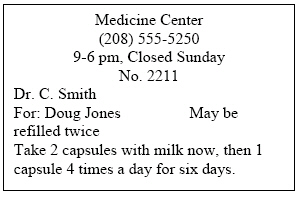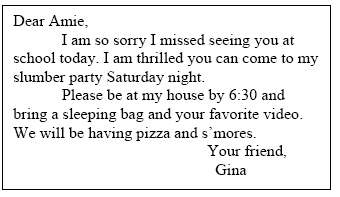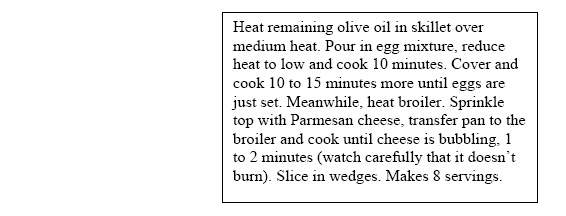Multiple Choice
Identify the choice that best completes the
statement or answers the question.
|
|
|
1.
|
Read the passage.
First, take the chunk of clay and mold it into the
shape that you want. Take the clay sculptor and save away rough edges. Sponge off the rough edges and
make sure the clay stays moist. Continue sculpting until you are satisfied with the final shape. Bake
in the kiln at setting 31/2 for 5 hours, or until you think the clay is sufficiently hardened.
Remove, cool, then glaze.
What would you do to check if the clay is hard enough?
a. | wait for the timer to go off and when the kiln cools, check your work | c. | open the kiln and
look at your sculpture | b. | try to speed up the timer so you can check the
sculpture and see if it’s finished | d. | take your sculpture out after 2 hours and then fix it again a second time after 2
more hours |
|
|
|
2.
|
Read the label from a prescription. When should Doug
drink milk? When should Doug
drink milk?
a. | with the capsules to wash them down | c. | after he has taken all of the
capsules | b. | 2-3 hours after a meal | d. | at least four times a day |
|
|
|
3.
|
Read the letter. The purpose of this letter is
to: The purpose of this letter is
to:
a. | invite Amie to the party | c. | thank Amie for attending the
party | b. | tell Amie what to bring to the party | d. | tell Amie she’s sorry she missed her at
school |
|
|
|
4.
|
Read the directions for a Spanish Omelet recipe.
Copyright Info: Ladies’ Home Journal, September 2002, www.lhj.com, page
168.When would cheese be added to this recipe?
a. | after the eggs are just set | c. | after the cheese is
melted | b. | before the eggs are completely cooked | d. | after the omelet has been sliced into
wedges |
|
|
|
5.
|
Literal Reading Comprehension—Reading for Detail--RIT 211 - 220
1.
Read the passage.
Plants need nutrients to make their food and get energy. Some plants that
grow in poor soil get the nutrients they need by “eating” animals. A sweet-smelling
liquid attracts insects to a pitcher plant. Once an insect enters the tube-shaped leaf of the plant,
hairs that point downward stop it from leaving. The insect falls into the pool of liquid inside the
leaf. The liquid dissolves the insect, and the plant uses the nutrients.
Copyright Info: Harcourt, Inc. 2002. School Permissions and Copyrights,
Harcourt, Inc., 6277 Sea Harbor Drive, Orlando, Florida 32887-6777.
Why do plants eat
animals or insects?
a. | they are natural predators | c. | they need them to produce a sweet
liquid that provides nutrients | b. | they do not eat animals or
insects | d. | they need the
nutrients |
|
|
|
6.
|
Read the passage.
Copyright Info:
Hakim, Joy. “Ruler of the President’s Navy”, Oxford University Press, Oxford, New
York, 1999.What was laid across the Mississippi to keep the Yankee ships
out?
a. | a chain of old boat | c. | planks of wood | b. | a chain of cannon balls | d. | tall mounds of
mud |
|
|
|
7.
|
Read the paragraph.
Throughout history, people have struggled for
their freedom—freedom to worship in their own way, to work for a fair wage, to vote for their
leaders, to get a good education, to name but a few. But rights and freedoms have always come with
certain restrictions and responsibilities. The challenge for every nation is to find a balance
between the two.Copyright Info: Not enough information given.
“Historical Documents” The Struggle for
Freedom, Page 865. (Teacher Author:
Weston).
According to the paragraph, which is true?
a. | It is a challenge for nations to treat their citizens kindly. | c. | Earning basic
rights and freedoms has been obtained through struggle and balance. | b. | America was the
first nation to fight for freedom. | d. | People were allowed to vote in 1850. |
|
|
|
8.
|
Read the paragraph.
Copyright Info:
Not enough information given. “Paragraphs” page 107. (Teacher Author:
Weston).
Which answer contains two details presented in the paragraph?
a. | Braille is a system of indented marks read by the seeing public. | c. | Braille creates
letters with cells, but does not create numbers. | b. | Braille, developed in 1800, is a series of
consistent dots. | d. | Braille is
a system of communication that has opened a new world for the blind. |
|
|
|
9.
|
Read the paragraph
Trees can be classified in several ways based on
their function or use. They are used most commonly for lumber or building products. Pine and oak are
among the most popular for this purpose. Trees, especially pine and other fast-growing trees, are
also used for erosion control and wind barriers. They are planted in rows on the tops and sides of
steep hills. Besides these uses, trees are considered extremely valuable for landscaping purposes
where they provide
shade, color, and screening for homes and businesses. Among the most popular
are evergreens, maples, honey locusts, and birch. Obviously, trees have many other uses as
well— just ask a bird...or a kid.Copyright Info: Not enough
information given. “Thinking” Classifying, page 552. (Teacher
Author:
Weston)
Based on the information above, trees:
a. | are used primarily for lumber and landscaping | c. | provide shade, especially
oaks | b. | don’t have many uses except to birds and kids | d. | enrich the soil by planting them in your
yard |
|
|
|
10.
|
Literal Reading Comprehension—Sequencing--RIT 211 - 220
Read the
Passage.
After Joel finished his run, he went and recorded his time on his log. It was his
best time he had recorded since his last run in October. Since then, he wondered if he was not in as
good of shape because his times seemed to be longer. After today, he would have to pay close
attention to what he was doing differently to make sure he was running as fast as he could.
How
would you paraphrase Joel’s events?
a. | Today’s run was as fast as October. | c. | Joel’s running times have not
changed. | b. | Joel has not improved his times since October. | d. | Joel has no idea how to get a better
time. |
|
|
|
11.
|
Read the Passage.
Utzel loved to sleep and each night he went to bed
with the chickens. In the morning he would complain that he was tired from so much sleeping and so he
went to sleep again. When he was not sleeping, he lay on his broken-down cot, yawning and
complaining. He would say to his daughter, “Other people are lucky. They have money without
working. I am cursed.”Copyright Info: Not enough information. Utzel
and His Daughter, Poverty, By Isaac Bashevis
Singer, page 149. (Teacher authors: Phillips,
Blackman, Felts).
Utzel loved to sleep. What does he do after he complains each
morning?
a. | He lays on his cot all day long. | c. | He complains he is
tired. | b. | He goes to bed with the roosters. | d. | He eats
breakfast. |
|
|
|
12.
|
Read the Passage.
What happened on Tuesday?
a. | I wanted a pop. | c. | The repairman fixed the pop machine. | b. | The chip machine
broke. | d. | The pop machine
broke. |
|
|
|
13.
|
Read the passage.
The alarm clock rang. Lali opened her eyes,
stretched out her arm, and pushed in the small knob that shut off the noise. She lay back staring at
the ceiling. Off in a corner the paint was peeling and a large crack made that section buckle. Every
day she cleaned the small chips of paint that fell on the dresser top and floor. She looked over at
Rudi’s side of the bed. He was gone. Each morning he awoke at five thirty and, except for
Sunday, reset the alarm at seven thirty for Lali. On Sunday the store was closed, but Rudi got up at
five-thirty anyway; he had been doing this for sixteen years. Since he always awoke before the alarm
went off, Lali wondered why he bothered to set the clock, and had asked him about it.
What does
Lali do right after she wakes up?
Copyright Info: Not enough
information. Stories of Newcomers, Lali, page 183. (Teacher
authors: Phillips, Blackman,
Felts).
a. | She looks over at Rudi’s side of the bed. | c. | She cleans up the paint
chips. | b. | She looks at the ceiling. | d. | She resets the alarm. |
|
|
|
14.
|
Read the note. What did Kim do after the
movie? What did Kim do after the
movie?
a. | ate pizza | c. | got some ice cream | b. | went to the mall | d. | went bowling |
|
|
|
15.
|
Read the Passage.
To find out what the symbols used on a map mean, you
must look at the map key. The map key explains what each symbol stands for. It is important to check
the map key on each map you use. A symbol that stands for one thing on one map may stand for a
completely different thing on another map.Copyright Info: Not enough
information. Reviewing Geography Skills, Independent Practice
Book, page 11. (Teacher author: Bev
Holtom).
What information is given before the map key on each map you use?
a. | It explains the map key. | c. | It asks you to look at two
maps. | b. | It defines a symbol. | d. | It asks what the color green stands for. |
|
|
|
16.
|
Read the non-fiction passage.
One difference between insects and all
other animals is the number of legs they have. Only insects have six legs in the entire animal
kingdom. Adult insects have four wings and two antennae on their heads.
If this is true, you
can conclude that:
a. | Spiders have wings; therefore, they are insects. | c. | Insects are only found in North
America | b. | All animals are insects. | d. | A grasshopper is an insect. |
|
|
|
17.
|
Literary Response and Analysis—Literary--RIT 201 – 210
Read
the passage.
Billy has all the weapons and versatility to become a Grand Slam Champion. He can
out-slug his opponents from the baseline or suffocate them at the net. But, the deciding factor could
be his deceptively powerful serve!
You can tell the competitive nature of the above passage
from the writer’s use of:
a. | word choice | c. | exaggeration | b. | humor | d. | seriousness |
|
|
|
18.
|
Read the passage.
The ball flew into the air with the force of a
lightening bolt. The crowd sat riveted by the tension in the air. If the home team caught the ball
and returned it, they would have a chance at winning the championship game! You could almost hear the
hopefulness as the ball began to descend to the icy field in slow motion. What did the future hold
for the Bobcats—glorious victory or unbearable defeat?
The passage is made more vivid by
the author’s use of:
a. | humor | c. | comparison | b. | descriptors | d. | syntax |
|
|
|
19.
|
Read the passage.
It is always possible to find fish and shellfish
along the waters edge in the early morning, and we walked with heightened awareness to find our quota
for the morning, so we could return to more important things, like playing in the trees and building
our fort. Ron walked behind me, and he was very distracted, “What do you think will happen to
the dolphins if they forget to come up for air?” he asked as he meandered along in my
footprints, not really helping with the task at hand. “They don’t forget, now get back to
work and help me,” I said in an irritated tone. Ron was only six years old, so I could hardly
blame him for his distraction, but I really was getting tired of being the older sister in charge all
the time. “Anna, he said, are you mad at me?” This made me feel guilty for snapping at
him, and I replied, “No I am not upset with you, I just want to get back to the camp and help
father and Tina with the rest of the daily chores, so I have some time for myself later.” Just
then I saw Brandon walking toward us with a basket full of shellfish.
Who is telling this
story?
a. | Anna | c. | Narrator | b. | Ron | d. | father |
|
|
|
20.
|
Read the passage.
Why did I raise my hand? He asked himself, but in
his heart, he knew exactly why he had bolted his hand in the air so fast. He longed for the spotlight
and the attention. What would I do in the talent show, John thought. I could sing, but Jake was a
much better singer. I could play the piano, but Carla would surely play her masterpiece and amaze
everyone. I have no idea what I am even thinking!
What can you infer about John?
a. | He is not a very good singer. | c. | He needs to think before raising
his hand so quickly. | b. | He is not a very good piano
player. | d. | He doesn’t
have very much self-confidence. |
|


